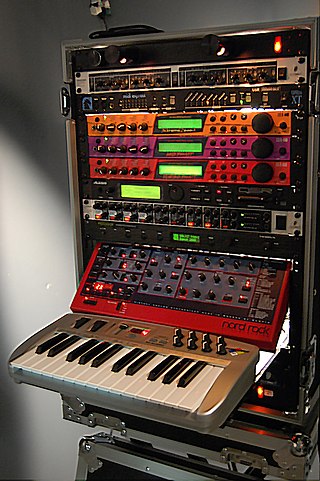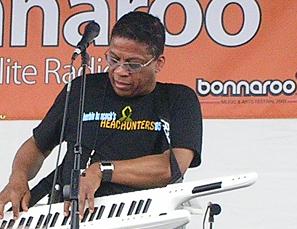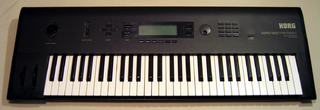
MIDI is a technical standard that describes a communication protocol, digital interface, and electrical connectors that connect a wide variety of electronic musical instruments, computers, and related audio devices for playing, editing, and recording music.

Yamaha Corporation is a Japanese musical instrument and audio equipment manufacturer.

CV/gate is an analog method of controlling synthesizers, drum machines, and similar equipment with external sequencers. The control voltage typically controls pitch and the gate signal controls note on-off.

An electronic keyboard, portable keyboard, or digital keyboard is an electronic musical instrument based on keyboard instruments. Electronic keyboards include synthesizers, digital pianos, stage pianos, electronic organs and digital audio workstations. In technical terms, an electronic keyboard is a rompler-based synthesizer with a low-wattage power amplifier and small loudspeakers.
Keytar is a keyboard instrument similar to a synthesizer or MIDI controller that is supported by a strap around the neck and shoulders, similar to the way a guitar is held.

Yamaha XG is an extension to the General MIDI standard, created by Yamaha. It is similar in purpose to the Roland GS standard.

The Yamaha QY10 is a hand-held music workstation produced by the Yamaha Corporation in the early 1990s. Possessing a MIDI sequencer, a tone generator and a tiny single-octave keyboard, the portable and battery-powered QY10 enables a musician to compose music while traveling.

A MIDI controller is any hardware or software that generates and transmits Musical Instrument Digital Interface (MIDI) data to MIDI-enabled devices, typically to trigger sounds and control parameters of an electronic music performance. They most often use a musical keyboard to send data about the pitch of notes to play, although a MIDI controller may trigger lighting and other effects. A wind controller has a sensor that converts breath pressure to volume information and lip pressure to control pitch. Controllers for percussion and stringed instruments exist, as well as specialized and experimental devices. Some MIDI controllers are used in association with specific digital audio workstation software. The original MIDI specification has been extended to include a greater range of control features.

A sound module is an electronic musical instrument without a human-playable interface such as a piano-style musical keyboard. Sound modules have to be operated using an externally connected device, which is often a MIDI controller, of which the most common type is the musical keyboard. Another common way of controlling a sound module is through a sequencer, which is computer hardware or software designed to record and playback control information for sound-generating hardware. Connections between sound modules, controllers, and sequencers are generally made with MIDI, which is a standardized interface designed for this purpose.

The Yamaha RM1x is a groovebox manufactured by Yamaha from 1999 to 2002. It integrates several, commonly separate, pieces of music composition and performance hardware into a single unit: a step-programmable drum machine, a synthesizer, a music sequencer, and a control surface.

The Roland Corporation has manufactured several keytars.

The Yamaha Motif is a series of music workstation synthesizers, first released by Yamaha Corporation in August 2001. The Motif replaced the EX series in Yamaha's line-up and was also based on the early Yamaha S series. Other workstations in the same class are the Korg Kronos and the Roland Fantom G. The series' successor is Yamaha Montage, released in 2016, followed up by the Yamaha Montage M in 2023.
The Casio AZ-1 is a polyphonic MIDI keyboard in the form factor of a keytar. It has a distinctive white body with a long neck, with detailing in a pale blue. This instrument is designed to be played, with the aid of a shoulder strap, in an approximation of an electric guitar. As were many keytars, it was geared towards keyboardists who wanted greater freedom of movement during performances.
Polyphony is a property of musical instruments that means that they can play multiple independent melody lines simultaneously. Instruments featuring polyphony are said to be polyphonic. Instruments that are not capable of polyphony are monophonic or paraphonic.

The Korg Wavestation is a vector synthesis synthesizer first produced in the early 1990s and later re-released as a software synthesizer in 2004. Its primary innovation was Wave Sequencing, a method of multi-timbral sound generation in which different PCM waveform data are played successively, resulting in continuously evolving sounds. The Wavestation's "Advanced Vector Synthesis" sound architecture resembled early vector synths such as the Sequential Circuits Prophet VS.

The Ensoniq VFX Synth was initially released as a performance type synthesizer in 1989. It was soon followed by the release of the VFX-SD, which included some updated waveforms, a 24-track sequencer and a floppy drive. Both models were equipped with the Ensoniq Signal Processing (ESP) chip for 24-bit effects. The VFX-SD also included two AUX outs, which allowed for a total of 4 outputs from the synth for more routing flexibility. The initial models were 21-voice polyphony, and in latter models of the VFX-SD (I/II) and the SD-1, the polyphony was 32.

The Yamaha CS2x is a sample-based synthesizer released by the Yamaha Corporation in 1999. The CS2x is designed for maximum real-time control, according to Yamaha. It is the successor of the very successful Yamaha CS1x. Enhancements include 64-note polyphony, a bigger sample ROM, a 24 dB/oct LPF/HPF filter and a two-band EQ per part/layer. The CS acronym stands for Control Synthesizer.
Rhythm game accessories are often required to play rhythm games available for various consoles, such as the PlayStation 2, PlayStation 3, Wii, and Xbox 360. These include dance pads, guitar controllers, drum controllers, microphones and turntable controllers. With the exception of microphones, these controllers can generally be used to control any game, but have limited inputs, making them impractical for most games.
The 12 Step foot controller is a bass pedal-style programmable MIDI controller pedal keyboard made by Keith McMillen Instruments which was released in 2011. It has small, soft, rubbery keys that are played with the feet. As a MIDI controller, it does not make or output any musical sounds by itself; rather, it sends MIDI messages about which notes are played to an external synth module or computer music program running on a laptop or other computer. Each key on the 12 Step senses the velocity, aftertouch pressure, and the amount of tilt the player is applying with his feet. The messages from the player's foot presses can be sent via USB to a computer-based virtual instrument or to a synthesizer or other electronic or digital musical instrument.













